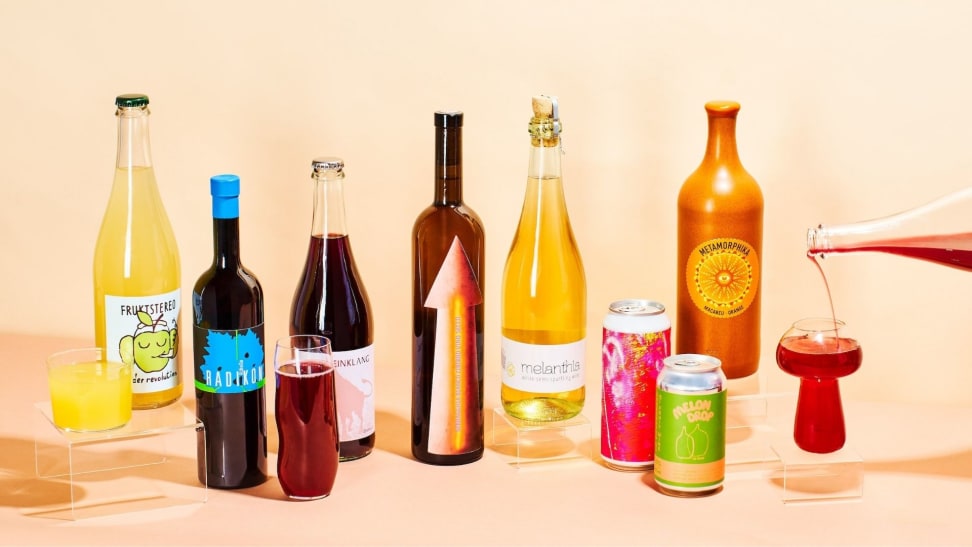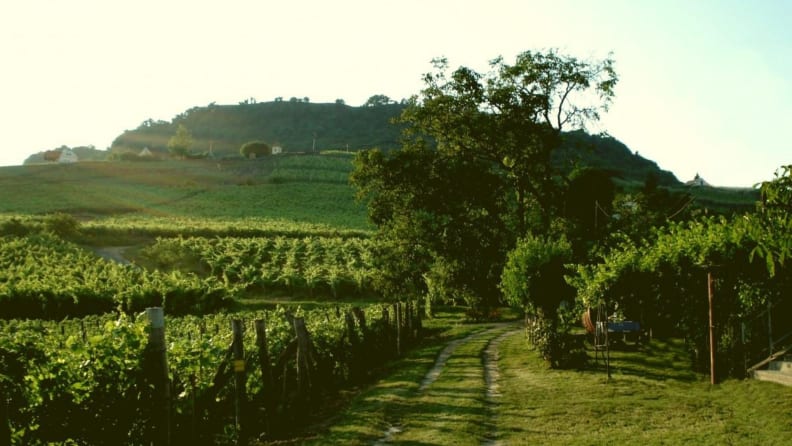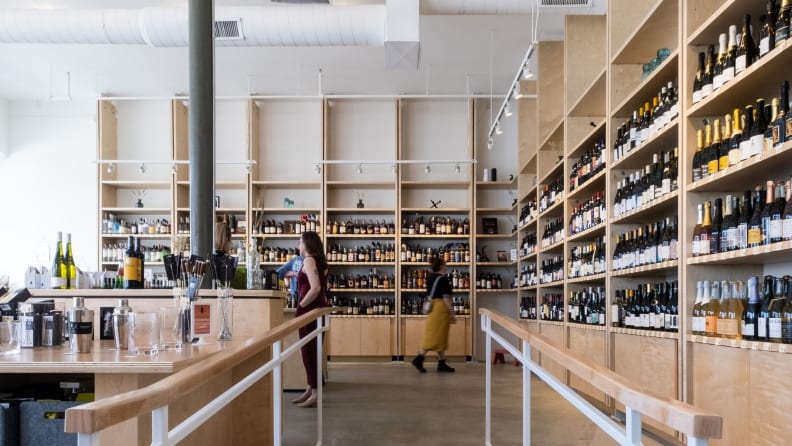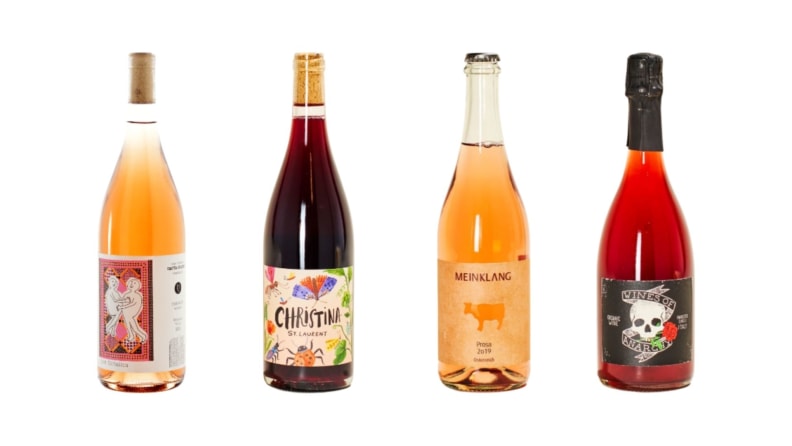Everything you need to know about natural wine
It’s here for a good time, and a long time.
 Credit:
Mysa Natural Wine
Credit:
Mysa Natural Wine
Products are chosen independently by our editors. Purchases made through our links may earn us a commission.
Maybe you’ve seen it in the wild at your favorite wine shop, heard your wine-o friends talk about it, or maybe scrolled past a photo of it on Instagram. Bold, graphic-designer-chic labels adorn bottles containing brightly colored wine, the names of which seem like something out of a fever dream: “Slipper Slippers,” “Royale with Cheese,” “Le Brutal!” Welcome to the world of natural wine!
This topic has become quite buzzworthy, so much so that it’s become the core concept behind wine bars, wine shops, Instagram accounts, indie publications, and more. But what exactly is natural wine? The definition varies depending on who you ask—as a natural wine scholar and professional wine slinger (I work for an e-commerce marketplace connecting wine lovers and winemakers natural wine), I like to tell folks that you can call wine natural if it’s made with minimal intervention.
When did people start making natural wine?
Natural wine has a long history, and in order to talk about why it’s such a hot topic today, we need to talk about its roots. The first evidence of wine made from grapes dates back to approximately 8,000 years ago in what’s now known as the Caucasus Mountains of Georgia and the Zagros Mountains of Iran.
Ever heard of orange wine? While this technique (made by fermenting white grapes with their skins still on) is super trendy today, this is actually how wine was made way back when—with minimal human intervention in large clay vessels called amphorae. But as with most things in life, winemaking processes and wine drinkers’ tastes changed, and conventional winemaking emerged as a result.
It may seem as though natural wine has exploded onto the scene in the last five or so years, but this modern movement started in the 1980s as a resistance against conventional wines with strict regulations and the points rating system (wine critic Robert Parker’s quality scale of 50 to 100). Natural wine, while harkening back to ancient practices, became a new form of rebellion. By the 2000s, “natural wine” (affectionately referred to as “natty wine”) became an established subgenre of the wine world.
What makes a wine natural?

Austria-based Meinklang is one of the leading producers of biodynamic wine.
Beyond the eye-catching, ‘grammable labels and cheeky names, each bottle has a story that starts in the vineyard and keeps going beyond the final sip in your glass. It starts with farming. Organic and biodynamic are the key buzzwords that swirl around this space.
Organic denotes that no pesticides or chemicals are used in the vineyards. Biodynamic takes organic and cranks it up a notch. Boiled down, biodynamic farming means farming with the moon cycles and treating the soil as a living organism. Regardless of whether grapes are grown organically or biodynamically, hand-harvesting is a standard practice when it comes to natural wine.
That said, what happens in the fields matters just as much as what happens in the winery. Once the grapes are harvested, winemakers take several steps to make sure they have a minimal impact on the fermentation process. In order for wine to ferment, yeast needs to be present.
When making commercial wine, the must (unfermented grape juice) is typically inoculated with store-bought yeast. Natural winemaking involves a process called spontaneous fermentation, or using native yeasts that already exist on the grapes and in the winery to ferment the juice. These processes occur after fermentation, before bottling, and are 100% au naturale.
Natural winemakers also make the choice to forgo many of the additives that are found in commercial wines. One such additive is sulfites. Sulfites spark a pretty big debate when it comes to making wine; On one hand, it acts as a preservative and stabilizer, preventing oxidation in wine. On the other hand, sulfites are a natural byproduct of the fermentation process, so it’s tricky for some winemakers to avoid them completely. While a tiny amount of sulfites will always exist in the bottle, natural winemakers usually eschew adding too many, if any at all!
Another hot topic is fining and filtration. When looking at a bottle of wine, sometimes it says “unfined and unfiltered” and you’ll notice some sediment and/or haziness. Don’t panic! Wine can be cloudy! Sediment is natural! This is OK! While there are certainly natural ways to clarify and filter a wine, some winemakers choose not to do so. A natural wine can be cloudy or clear, filtered or unfiltered. This falls into the “winemakers’ choice'' category.
While sulfites, fining, and filtration are heavy hitters in the debates surrounding natural wine and additives, this is by no means an exhaustive list. According to Deirdre Heekin, owner of La Garagista Farm + Winery in Vermont, the U.S. government allows over 72 additives to go into wine production. That’s a lot of extra stuff to put into wine, and overall contrary to the natural wine ethos, so generally speaking you won’t find many additives in natty bottles.
Can I still buy my favorite varietals?
Oh heck yeah! One thing to know about natural wine is that all grapes are on the table. However, don’t expect that the Sauvignon Blanc you’ve been buying for years will taste the exact same as the cool new natty one you picked up for yourself. Natural wines, while showcasing the land more than the processes of conventional wines, can show some variation between years and even bottles, even if the wine is the same.
While natural wine is produced with minimal intervention, a lot happens to the juice (and eventually, wine) that creates flavor fluctuation, like spontaneous fermentation. Your hot new natty wine might not be an exact copy of the Sauv Blanc you usually get, but part of natural wine is the thrill of the unknown.
How to spot a natural wine in the wild

If you live in or near a big city, chances are you'll be able to find a natural wine shop, like the Atlanta, Georgia-based Elemental Spirits Co.
Now, you might be asking: “But Steph, if I don’t know of any natural wine producers, how can I spot one on the shelf?” Enthusiastic reader, I’m glad you asked. In the vast world of natural wine, a few things can indicate that the bottle you’re eyeing is good old fashioned natty.
First, turn the bottle around and look for the importer label. Certain importers have built up reputations for their portfolios full of producers who espouse the pedagogy of natural wine, from biodynamic Champagne with elegant flair to a funky Syrah exploding with fruit and fun. Zev Rovine, Jenny and Francois, Louis Dressner, and Neil Rosenthal all offer portfolios with an excellent range of natural wine from around the world.
Second, check the almighty certifications. Look for the USDA’s National Organic Program, EU Organic, and Demeter, the most prevalent biodynamic certification.
If you’re still stumped, ask your favorite local wine specialist. There’s a good chance that someone working at your favorite shop wants to share their knowledge of natural wine with you. Plus, it’s always a good idea to make friends with your local wine slinger. They’ll keep you in mind, learn your tastes, and let you know when a bottle you might enjoy arrives on the shelf.
Natural winemakers to look out for

Keep an eye out for these bottles next time you're at your local wine shop.
Christina
The eponymous wines made by Christina Netzl are hard to miss. Aside from the wine inside the bottles (brightly colored and sure to draw you in!), please notice the labels! If you’re thinking, That looks like a bunch of bugs, then you’re right; these illustrated critters are all the hardworking bugs that help take care of the vineyard ecosystem.
Get Christina wines at Mysa Natural Wine starting at $23.95
Meinklang
An Austrian winemaking powerhouse. Meinklang is the largest biodynamic farm in Austria, located in Burgenland, south of Vienna and on the border of Hungary. Their wines will make you believe in magic.
Get Meinklang wines at Mysa Natural Wine starting at $19.95
Martha Stoumen
Stoumen crafts wine that hearkens tradition with a sense of California cool. In addition to classic California varietals, she produces Italian varietals for a bit of Old World charm with New World flair.
Get Martha Stoumen wines at Mysa Natural Wine starting at $32.95
Agricola Cirelli
With a line of bottles named Wines of Anarchy, it’s clear that this Italian producer is bringing a new school approach to contemporary Italian winemaking. Some of these wines are made in amphorae, like the original natty wines way back when, and everything from this maker is 100% organic.
Get Agricola Cirelli wines at Mysa Natural Wine starting at $16.95
Where to buy natural wine online
If you’ve made it this far and are ready to order some natural wine ASAP, you’re in luck! There are plenty of places to buy wine online, from dedicated wine subscriptions to monthly pickups at your local bottle shop. Here are some of my favorite places to buy natural wine online:
Mysa Natural Wine is a natural wine club that offers a few different options (like a red or orange option, for those of you who want to avoid white wine). As a wine club member, you’ll get 10% off retail bottles in their online shop.
Primal Wine is a great customizable option for those of you who want only one kind of wine. Pick your type (red, white, or mixed), how many bottles you’d like, and the Primal team will take care of the rest. Our editor recently tested this service and was impressed with Primal’s selection.
Domestique is a super cool wine shop in the Bloomingdale neighborhood of DC, and they’ve got an amazing wine club curated by Director of Sales Eric Moorer. He does an Instagram Live each month to showcase the current picks and he pairs them all with music! Don’t want to join the club? Just order wine.
Helen’s Wines is a woman-owned wine shop based in Los Angeles, California that offers a few different wine club options. They have monthly and seasonal subscriptions with two bottles, as well as seasonal curated half and full-case options.
At its core, natural wine is exactly that, wine. It’s fun, it’s exciting, and it tastes amazing. In my opinion, it’s wine the way wine is meant to be, and who could be mad about that?


